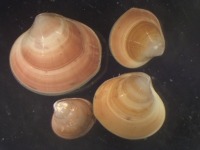
(Photo: Huntsman Marine Science Centre)
Ocean Quahog
Arctica islandica
This bivalve has a thick, oval to rounded shell. The shell has many fine concentric lines and is white with a dark skin (periostracum) that flakes off of dead and dry individuals. This periostracum is brown in small individuals but can turn black/green as they grow larger. They have a noticeable curve on one side of their hinge. The shell can be up to 13 centimetres in diameter.
Authority
Linnaeus, 1767
Classification Details
Phylum: Mollusca (molluscs); Class: Bivalvia (bivalve molluscs).
Habitat
Found on both sides of the North Atlantic Ocean but restricted to cooler waters under 16°C. In the western Atlantic, their range is from Labrador to North Carolina. Found on sandy seabeds where they bury themselves in the top few centimetres. Recorded at depths of four to 482 metres.
Diet
Adults use their siphons to suck in suspended particles, phytoplankton, and film from the surface of the seabed. They then filter out the particles using their gills.
Reproduction
This species can be male or female. Individuals become sexually mature between five and 14 years old. Individuals release eggs or sperm and fertilization takes place in the seawater. The spawning period is related to water temperature. Spawning occurs between July and September off Nova Scotia. Eggs hatch into trochophore larvae that develop into veliger larvae, then finally pediveliger larvae, before settling on the seabed. The larval period ranges between 32 and 55 days, taking longer at lower temperatures.
Fun Facts
Scientists discovered that an ocean quahog known as “Ming” was 507 years old. Ming would have been born in 1499 - only a few years after Columbus visited America for the first time. The age of bivalves like Ming can be determined by counting growth rings in their shells.
References
Butler PG, Wanamaker AD, Scourse JD, Richardson CA, Reynolds DJ (2013) Variability of marine climate on the North Icelandic Shelf in a 1357-year proxy archive based on growth increments in the bivalve Arctica islandica. Palaeogeography, Palaeoclimatology Palaeoecology, 373, 141–151. FAO. Species Fact Sheets – Arctica islandica. FAO FishFinder. http://www.fao.org/fishery/species/3534/en Consulté en ligne le 19 janvier 2020. MolluscaBase (2020) MolluscaBase. Arctica islandica (Linnaeus, 1767). Accessible via : World Register of Marine Species at: World Register of Marine Species at http://www.marinespecies.org/aphia.php?p=taxdetails&id=138802 Consulté en ligne le 19 janvier 2020.

